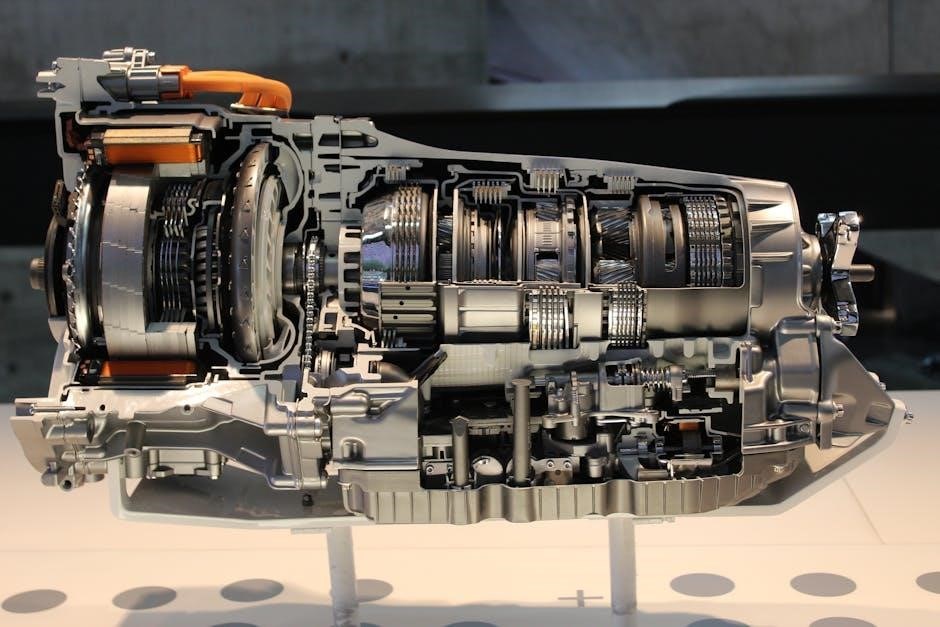Understanding the 6L80 Transmission Pan Torque Specs

The 6L80 transmission pan bolt torque specifications are crucial for maintaining transmission integrity. Proper torque prevents leaks and ensures fluid retention. The recommended torque is 80 in-lbs‚ as specified in the Haynes manual and multiple online sources. Over-tightening can damage bolts and the pan.
Overview of the 6L80 Transmission
The 6L80 transmission is a 6-speed automatic transmission developed by General Motors (GM). Introduced in 2006‚ it was GM’s first 6-speed automatic transmission‚ designed to improve fuel efficiency and performance in trucks and SUVs. Known for its robust design‚ the 6L80 features a 32-bit transmission control module‚ five clutch packs‚ and one sprag. It is widely used in vehicles such as the Chevrolet Silverado‚ GMC Sierra‚ and other GM trucks and SUVs.
The transmission is capable of handling high torque inputs‚ with an input torque capacity of up to 430 lb-ft (583 Nm) and an output torque capacity of 664 lb-ft (900 Nm). It features a wide gear ratio spread‚ with ratios of 4.02:1 (1st)‚ 2.36:1 (2nd)‚ 1.53:1 (3rd)‚ 1.15:1 (4th)‚ 1.00:1 (5th)‚ and 0.66:1 (6th)‚ providing smooth acceleration and efficient cruising. The final drive ratio is typically around 3.23:1‚ depending on the application.
The 6L80 is also equipped with a lock-up torque converter‚ which helps reduce slippage and improves fuel efficiency. Its advanced clutch packs and pressure controls enable precise shifting and adaptability to driving conditions. Regular maintenance‚ such as changing the transmission fluid every 30‚000 miles‚ is essential to ensure optimal performance and longevity.
Overall‚ the 6L80 transmission is a reliable and versatile component‚ well-suited for both everyday driving and heavy-duty applications‚ including towing and hauling. Its advanced engineering and durable construction make it a key part of GM’s lineup for over a decade.
Importance of Torque Specs for the Transmission Pan
The torque specifications for the 6L80 transmission pan are critical to ensure the transmission operates correctly and maintains its structural integrity. Properly torqued pan bolts prevent fluid leaks‚ which can lead to significant damage due to insufficient lubrication and cooling. Over-tightening or under-tightening can compromise the gasket’s seal‚ causing leaks and potentially costly repairs.
Incorrect torque application can also result in stripped threads or broken bolts‚ which may require extensive labor to fix. Additionally‚ improper torque can affect the transmission’s ability to regulate fluid pressure‚ leading to poor shifting performance and reduced transmission lifespan. Following the specified torque value of 80 in-lbs ensures the pan is securely attached without over-stressing the components.
Adhering to the torque specs is especially important during routine maintenance‚ such as fluid changes or pan replacements. Using a torque wrench and following the correct sequence helps distribute the force evenly across the pan‚ preventing warping or damage. Proper torque ensures reliability‚ performance‚ and longevity of the 6L80 transmission.
6L80 Transmission Pan Bolt Torque Specifications

The 6L80 transmission pan bolt torque specifications are crucial for ensuring proper installation and functionality. According to the Haynes manual and multiple online sources‚ the recommended torque for the pan bolts is 80 in-lbs. This specification is consistent across various models and years‚ ensuring a reliable seal and preventing potential leaks.
It’s important to use a torque wrench calibrated for precision at lower torque values‚ as 80 in-lbs is relatively low. Additionally‚ ensuring the bolts are properly seated and aligned before applying torque helps prevent stripping or damage to the threads. Over-tightening beyond the specified torque can lead to bolt failure or pan warping‚ while under-tightening may result in fluid leaks.
Always refer to the manufacturer’s official documentation or a trusted repair manual for accurate specifications. Proper torque application ensures the transmission pan is securely attached‚ maintaining the integrity of the transmission system and preventing costly repairs. Adhering to these torque specifications is essential for the longevity and performance of the 6L80 transmission.
Correct Torque Sequence for the 6L80 Transmission Pan
When tightening the bolts on the 6L80 transmission pan‚ following the correct torque sequence is essential to ensure even pressure distribution and prevent warping of the pan. The recommended sequence starts from the center bolt and alternates outward in a star pattern. This method ensures that the gasket is evenly compressed‚ minimizing the risk of leaks.
Using a torque wrench set to 80 in-lbs‚ complete the sequence by tightening all bolts in the specified order. Once all bolts are torqued‚ double-check each one to ensure they meet the torque specification. Proper sequencing and torque application are critical for maintaining the transmission’s integrity and preventing premature wear or damage to the pan and gasket.
Consequences of Incorrect Torque Application
Incorrect torque application on the 6L80 transmission pan bolts can lead to serious complications. Over-tightening beyond the specified 80 in-lbs may result in stripped threads‚ damaged bolts‚ or a warped pan‚ requiring costly repairs. Conversely‚ under-tightening can cause leaks‚ as the gasket may not seal properly‚ leading to fluid loss and potential transmission damage.
Transmission fluid leaks can progress rapidly‚ causing decreased fluid levels and insufficient lubrication. This can result in overheating‚ accelerated wear on internal components‚ and eventual transmission failure. In severe cases‚ neglecting proper torque specs may necessitate complete transmission disassembly and rebuilding‚ which is both time-consuming and expensive.

Moreover‚ improper torque application can void warranties or damage related components‚ such as the torque converter or transmission case. It is critical to adhere to the specified torque sequence and values to ensure the integrity of the transmission system and prevent premature failure. Always use a torque wrench and follow the recommended sequence to avoid these costly consequences.
Additional Resources for 6L80 Transmission Pan Specs
For precise and reliable information on 6L80 transmission pan torque specifications‚ several resources are available to ensure accuracy and safety during repairs or maintenance. The Haynes repair manual is a trusted source‚ providing detailed torque values and sequences for the 6L80 transmission‚ including the pan bolts. Additionally‚ Global Transmission Parts offers comprehensive technical data‚ including torque specs‚ bolt grades‚ and tightening sequences specifically for the 6L80 and 6L90 transmissions.
Online forums and communities‚ such as those dedicated to Chevrolet Silverado or GMC Sierra owners‚ often share real-world experiences and verified torque specifications. Factory service manuals are another invaluable resource‚ offering official GM specifications for transmission assembly and maintenance. For visual guidance‚ YouTube tutorials and repair videos demonstrate the correct application of torque to the transmission pan bolts.
Always consult multiple sources to confirm the accuracy of the torque specs‚ as incorrect application can lead to costly repairs. Ensuring adherence to the recommended 80 in-lbs (6.6 ft-lbs) torque for the pan bolts is critical for maintaining the integrity of the transmission system.
Related Torque Specs for 6L80 Transmission Components

Beyond the transmission pan‚ the 6L80 transmission has several other components requiring specific torque specifications for proper assembly and function. The transmission case bolts‚ for instance‚ typically require a torque of 50 Nm (37 lb-ft)‚ ensuring a secure connection to the engine. The valve body bolts also have precise torque requirements‚ often specified at 9 Nm (7 lb-ft)‚ to maintain hydraulic control and prevent leaks.
Internal components‚ such as the clutch packs and planetary gear sets‚ may have torque-to-yield specifications that must be followed meticulously. These specs are crucial for ensuring the transmission’s internal integrity and performance. Additionally‚ the mounting hardware‚ including crossmembers and brackets‚ typically requires torques ranging from 40-60 Nm (29-44 lb-ft)‚ depending on the application and vehicle weight distribution.
Consulting the factory service manual or reputable sources like Global Transmission Parts ensures accurate and reliable torque values for all 6L80 components. Proper torque application across all parts is essential to avoid premature wear‚ leaks‚ and potential system failure. Always verify specs for your specific vehicle and transmission configuration to maintain optimal performance and durability.
Troubleshooting Common Issues with 6L80 Transmission Pan Bolts
Common issues with 6L80 transmission pan bolts often stem from improper torque application. Over-tightening can result in stripped threads or broken bolts‚ while under-tightening may lead to fluid leaks; Symptoms of these issues include visible leaks‚ inconsistent transmission performance‚ or difficulty removing the bolts during maintenance.
One frequent problem is exceeding the recommended torque of 80 in-lbs‚ which can damage the pan or bolts. Users have reported breaking bolts even at this specification‚ raising concerns about bolt quality or torque wrench accuracy. To address this‚ ensure your torque wrench is calibrated and avoid using impact wrenches‚ which can apply excessive force.

If bolts are over-torqued‚ removal can become challenging. Applying penetrating oil and gently heating the area may help. In severe cases‚ professional extraction tools or helicoil repairs may be necessary. Always replace damaged bolts with OEM or equivalent-grade hardware to maintain system integrity.
Regular inspection of the transmission pan bolts during fluid changes is recommended to catch issues early. If leaks persist after re-torquing‚ the pan gasket may need replacement. Refer to the factory service manual or trusted sources like Global Transmission Parts for accurate specifications and troubleshooting guidance.
Step-by-Step Guide to Replacing the 6L80 Transmission Pan
Replacing the 6L80 transmission pan involves a systematic approach to ensure proper installation and prevent future issues. Start by gathering necessary tools and materials‚ including a new pan‚ gasket‚ bolts‚ and torque wrench. Jack up the vehicle and secure it with jack stands for safe access.
Next‚ locate the transmission pan‚ typically found at the bottom of the transmission. Use a drain pan to catch any remaining fluid when removing the old pan. Carefully remove the bolts in a star pattern to avoid warping the pan or stripping threads. Once the bolts are out‚ gently pry the old pan loose and remove it.

Inspect the area for any old gasket material and clean it thoroughly. Apply a thin layer of sealant to the new gasket and install it onto the transmission. Mount the new pan‚ ensuring it is properly aligned with the bolts. Tighten the bolts in the recommended sequence‚ following the specified torque of 80 in-lbs. Avoid over-tightening to prevent damage.
Finally‚ refill the transmission with the appropriate fluid‚ typically Dexron VI‚ and lower the vehicle. Start the engine and check for leaks around the pan. Proper installation ensures optimal transmission performance and longevity. Always refer to the factory manual or trusted sources like Haynes for detailed instructions.
Torque Converter and Transmission Pan Compatibility
The torque converter and transmission pan in the 6L80 system are designed to work in harmony‚ ensuring smooth power delivery and fluid circulation. The torque converter is responsible for transferring engine power to the transmission‚ while the pan holds the vital transmission fluid. Compatibility between these components is crucial for optimal performance.
The 6L80 transmission is engineered to handle a maximum input torque capacity of 430 lb-ft (583 Nm) and an output torque capacity of 664 lb-ft (900 Nm). The torque converter must be properly aligned and installed to match these specifications‚ ensuring efficient energy transfer. Misalignment or incorrect installation can lead to poor performance and potential damage.
The transmission pan and torque converter are both designed to work with Dexron VI fluid‚ which provides the necessary lubrication and cooling properties. Using the correct fluid ensures compatibility and prevents degradation of internal components. Proper installation‚ including torque specs of 80 in-lbs for pan bolts‚ is essential to maintain the integrity of both components.
Always refer to the factory manual or trusted sources like Haynes for detailed instructions to ensure compatibility and proper function of the torque converter and transmission pan in your 6L80 system.